


FOSSIL Project / Dry Dredgers Mini-Conference Field Trips
Thursday, June 2, Friday June 3 and Sunday June 5, 2016
Report and photos by Bill Heimbrock



In June 2016, the Dry Dredgers and the FOSSIL Project along with the Cincinnati Museum Center and the University of Cincinnati Geology Dept. held a mini-conference on paleontology. This was a well organized gathering of fossil clubs and professional paleontologists from around the country with the goal to foster collaborative efforts between amateur and professional paleontologists.
This was a landmark meeting in every sense of the term. The Dry Dredgers have long been known for their history of amateur paleontology. Now the FOSSIL Project, based at the Florida Museum of Natural History, and funded by the National Science Foundation, is cultivating a networked community in which amateur and professional paleontologists collaborate in the practice of science, and outreach.
The entire conference was free to those who registered on myfossil.org. This was an excellent opportunity for anyone wanting to learn more about fossils and fossil sites near Cincinnati, Ohio.
Our conference consisted of three days of field trips (Thursday, Friday and Sunday) and one day of meetings (Saturday). Sounds good to me.
Thursday's field trip was to
Big Bone Lick.
Glenn Storrs the vertebrate curator
of the Cincinnati Museum of Natural History and Science gave an in-depth tour of
the park and the history behind this historic site. 30 people attended the tour.
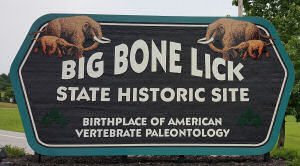
For Friday and Sunday's field trips, the Fossil Project rented four vans in which most attendees road from site to site. Dr. Carl Brett of the University of Cincinnati led these field trips and provided an excellent talk at each location describing the stratigraphy, the fossils and the paleoecology. In these two days we covered the entire Cincinnatian Series using stratigraphy across two states - Indiana and Kentucky.
Kyle Hartshorn, in conjunction with Jack Kallmeyer and Carl Brett, provided an
excellent and thorough guide book (shown below) titled "Dry Dredgers the
Cincinnati Arch" which covered every aspect of Cincinnati paleontology and the
sites we were visiting.

Friday June 3, 2016: Northeastern Kentucky
Friday was dedicated to sites in Northeastern Kentucky. We first met at 6 am at
the Radison Hotel in Covington, KY and proceeded to a nearby parking lot big
enough for us to all park our cars and load into the rented vans.
Dr. Dave Meyer of the University of Cincinnati Geology Dept supplied the
donuts, which we enjoyed.

Site 1: Edenian Stage and Maysvillian Stage
Our first stop was a huge road cut in Mason County, Kentucky. We started at the
bottom of the cut in the Kope Formation. It had rained overnight and the site
was pretty muddy and slippery. So we didn't climb up on the ledges to fossil
hunt. But Dr. Carl Brett kept us together with an informative and enlightening
talk on the layers exposed. Here are a few great photos.
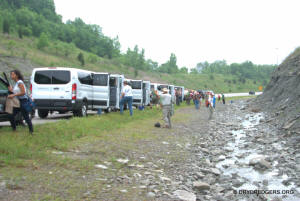
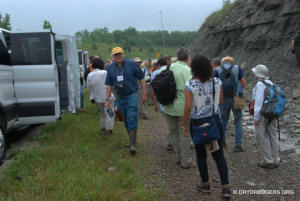
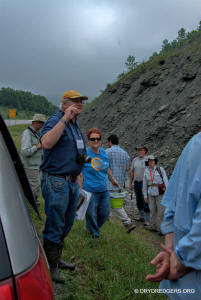
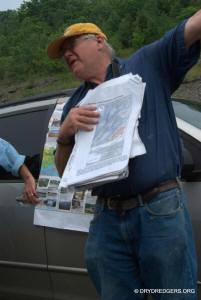
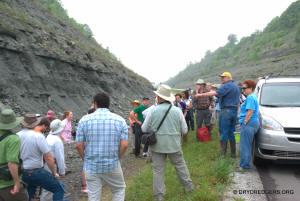
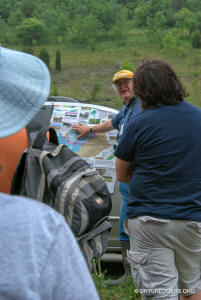
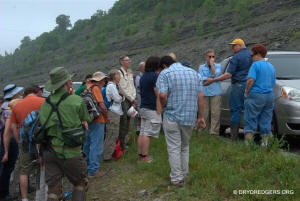
Dr. Ben Dattilo acted as a marker as Carl Brett pointed to specific layers.
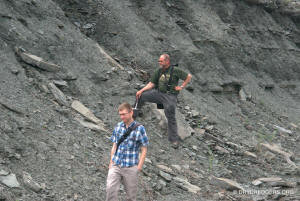
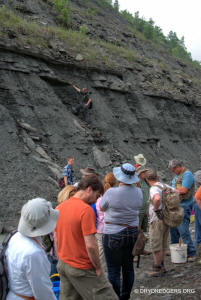
Carl Brett shows off some
Rusophycus Ichnofossils found on this site and allows
photo opportunities.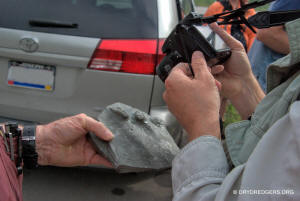
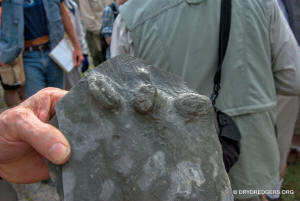
Other attendees were quick to find actual
Flexicalymene sp. trilobites. The one below being examined by
Dr. Carl Brett is inverted.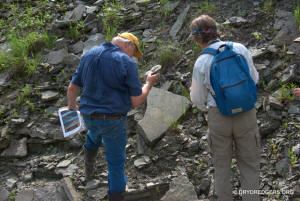
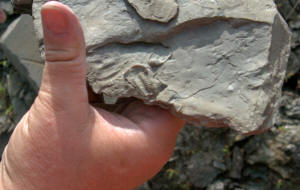
I was able to find a nice set of trace fossils that may be trilobites burrowing
as they fed.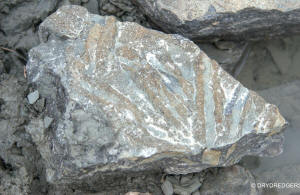
Other trace fossils made by worms and other animals were also found that day.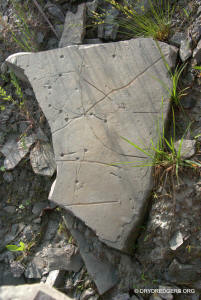
Chuck Ferrara, president of the
Southwest Florida Fossil
Society, examines large scale ripple marks that were once at the bottom of
the sea in Late Ordovician times (450 million years ago).
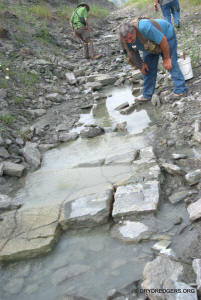
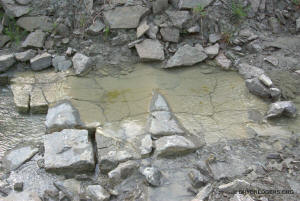
It certainly was a meeting of the minds, which is precisely one of the goals of the conference. Here's Dr. Carl Brett (UC) discussing details of the site with Dr. Tony Martin of Emory College of Arts and Science while numerous onlooking amateur paleontologists listen and learn.
After exploring the Kope Formation, the vans moved up to the part of the road
that exposed the Fairview Formation. We hiked up to that location and began
looking for the unique fossil fauna of the Fairview.
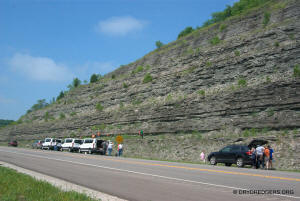
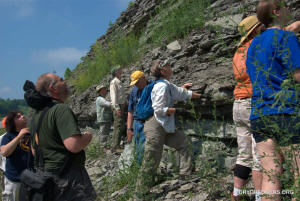
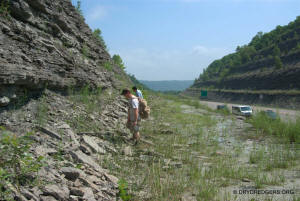
By this time, we were ready for lunch. We were taken to a nearby park where subs
from Subway were waiting for us. Thanks to President Jack Kallmeyer for fetching
it. (This was a free lunch BTW).
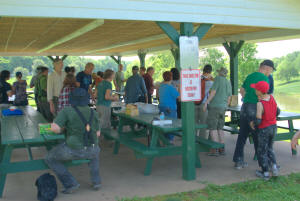
Friday Site 2: Corryville and Mount Auburn members of the Grant Lake Formation
The site for Friday afternoon picked up about where we the
morning's site left off - climbing up the strata and through time. Once again
Dr. Carl Brett gave us a guided tour of the site and what we can find here.
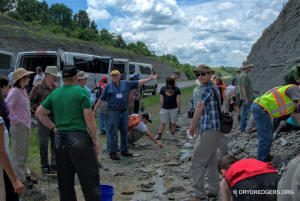
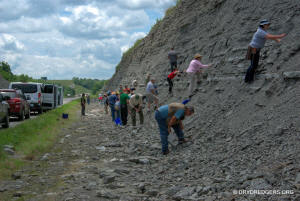
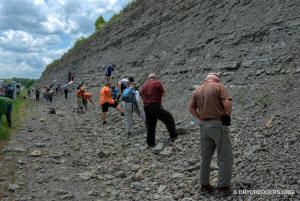
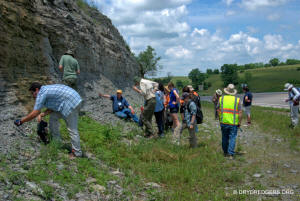
The first thing Carl pointed out to us was that we could find
abundant quantities of an algae "Solenopora," which
appeared as wrinkled brains littering the tallus.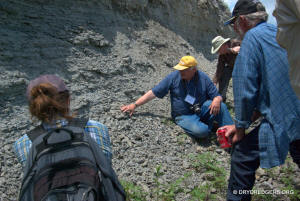
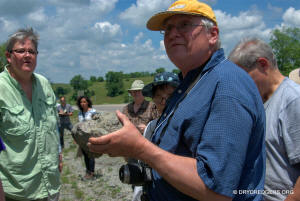
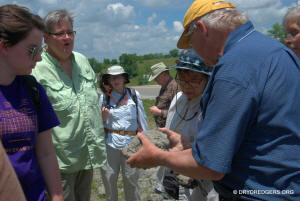
This algae coated particles to form Oncolites
and also began to coat nautiloid cephalopod shells as seen in the next 2 photos.
Dr. Brett also pointed out a layer rich in
Stromatoporoids.(next 4 pics)
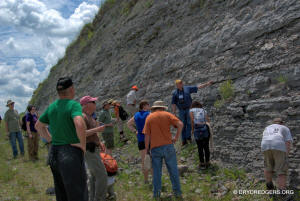
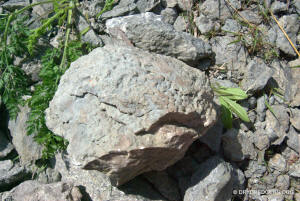
Some of the forms similar to the "brain algae
Solenopora" and the Stromatoporoids were
actually massive trepostomate bryozoans like the one I found shown below (next 2
pics).
As we ascended up the strata, Dr. Brett pointed out a
gastropod layer.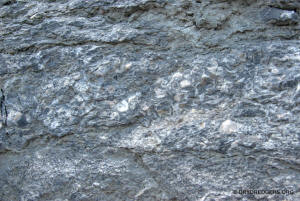
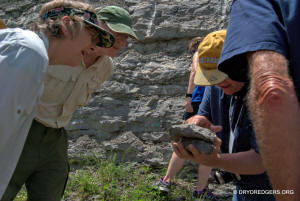
Here are a couple of the gastropods I found loose in the talus
near this gastropod layer.
Eventually we found ourselves in the Arnheim. Here we began to
find the first occurrences of the brachiopod
Leptaena sp.
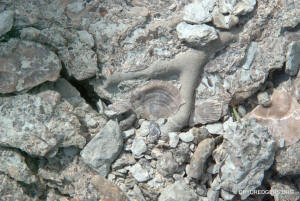
Other brachiopods found included
Vinlandostrophia sp.
For Sunday, we toured southeastern Indiana. Here we picked up where we left off on Friday and continued up the strata from the Maysvillian Stage into the Richmondian Stage of the Cincinnatian Series. We started off at 6 am again, the same way we had on Friday morning and loaded into vans. The very thorough field guidebook Kyle Hartshorn had prepared indicated we would hit three Indiana sites today.
Site 1: Bellevue, Corryville and Mt. Auburn members of the Grant Lake Formation
For our first site of Sunday was a roadside hill exposure in Switzerland County Indiana. Kyle Hartshorn of the Dry Dredgers began the tour, explaining where different types of fossils could be found. This site was a lot of fun. Brachiopods were super abundant, particularly Vinlandostrophia ponderosa, V. laticosta, V. cypha, Rafinesquina ponderosa and Hebertella occidentalis.
The consistent theme on this site, based on the fossils we saw was that we had a long period at this location about 445 million years ago without a lot of calcareous mud sediment being deposited. At the bottom of the hill, Dr. Ben Dattilo and I examined a phosphate-rich sediment full of internal molds of snails, clams, byrozoans and negative impressions of shell surfaces. This was the subject of his and my recent paper in the March issue of Palaios. And here it was to see at the top of the Fairview and the bottom of the Bellevue.
But it was Kyle Hartshorn who found the smoking gun. On the
surface of one slab loaded with phosphatic steinkerns (1st photo below), there was a tiny
structure that had been identified years ago but only
recently documented
(second photo). It's the negative impression of the surfaces of a bivalve
hinge dentition. This was the "Mystery
Fossil" that I had puzzled over for decades. The red block in the
first photo indicates the frame of the second photo.
As we moved up the hill we began to find lots of the
brachiopod Rafinesquina ponderosa
(next 3 pics).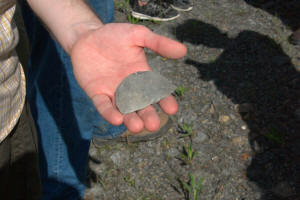
Even more abundant were the ponderously large brachiopod Vinlandostrophia ponderosa.
This site was also loaded with inarticulate brachiopods
inhabiting the surfaces of articulate brachiopods. If you look closely at the
next articulate brachiopod, you'll see an inarticulate brachiopod on it. The
inarticulate is Petrocrania scabiosa.
Here's another articulate brachiopod that these inarticulates
were inhabiting - Hebertella sp.
Even the bryozoans showed evidence of epifauna. Check out the
surface of this trepostomate bryozoan full of holes probably associated with
Trypanites.
Nautiloid cephalopods were not abundant on this site, but a
few fragments were found, like the internal mold below.
Sunday Site 2: The Richmondian Stage and Lower Silurian
As our tour progresses up the stratigraphic column, we take the vans to our second site, a big road cut in Jefferson County, Indiana.
Once again, Dry Dredger Kyle Hartshorn begins the site tour
with information on the strata and what can be found.
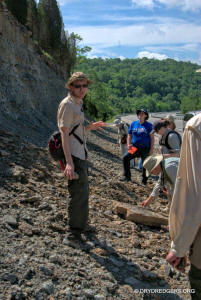
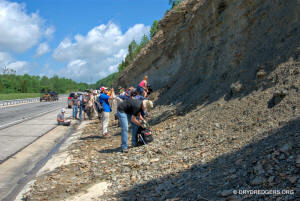
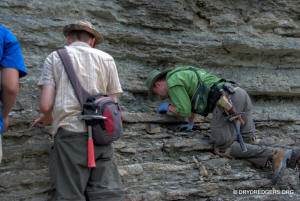
Dr. Carl Brett was also on hand to give us a level of insight
that only he can.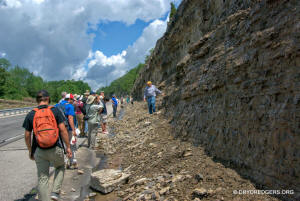
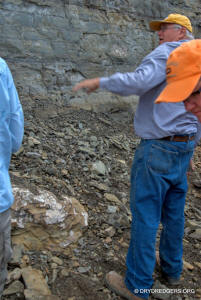

This site has been studied before, as evidenced by the
markings on the rock layers.
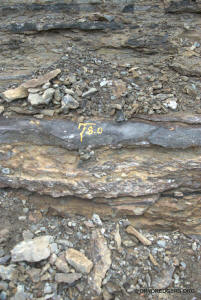
A layer at the top of the Liberty formation is comprised
largely of bivalves. Here's one I found.
Higher on this site, we found the Saluda member of the
Whitewater formation. This layer is known for coral. We saw a four meter-thick
layer of big fat coral heads. Here is one colonial coral that was found in the
talus (1st photo) and some horn coral called
Grewingkia canadensis
(2nd photo).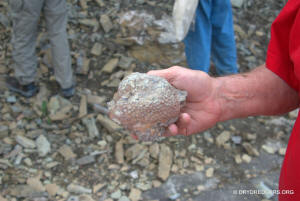
Dr. Carl Brett pointed out to us that some of these dark bands
in the Saluda Dolomite of this site represent monthly tidal cycles. This is an
amazing record of small scale time where normally rocks represent thousands of
years of time. (next 2 photos).
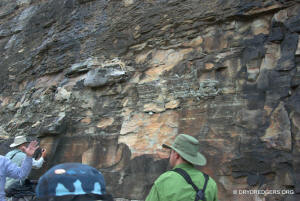
Sunday Site 3: The Richmondian Stage
After a nice lunch in a park overlooking the Ohio River, we
went to a huge road cut in Dearborn County, Indiana that the Dry Dredgers
have visited many times. This is the site where
we look in the large shale ledge for the tiny trilobite
Flexicalymene retrorsa minuens.
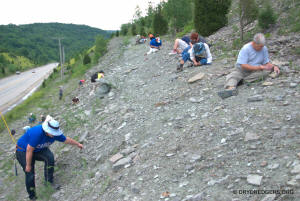
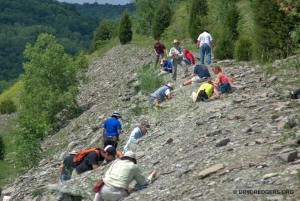
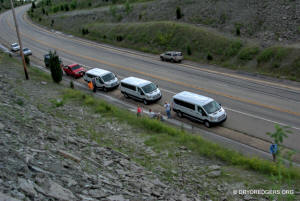
A couple of attendees did find these trilobites. But despite
the recent rains, not everyone did. I personally found a decent variety of clam
internal molds. This first one has enough markings to tell it's probably
Ambonychia sp.
This next one, showing both sides of the shell looks like
Modiolopsis sp.
And this last one is probably a worn specimen of
Caritodens sp.
No crinoid calyxes were found as far as I know, but plenty of
stems like the ones shown below were found.
As for brachiopods, more than a dozen varieties of brachs can
be found on this site. I picked up just two. The first is a single valve of
Plaesiomys subquadratus.
And here is a
Hebertella sp. from the site.
That's all I have for the FOSSIL Project Cincinnati Mini-conference! There are too many people to thank that they can't be listed here. But I would like to thank the team of the Fossil Project, Jack Kallmeyer and Kyle Hartshorn of the Dry Dredgers and Dr. Carl Brett of the U.C. Geology Dept for making these field trips very worthwhile. And a special thanks to Dr. Dave Meyer for those delicious donuts and coffee.
Read more about the Cincinnati Mini-Conference in Jack Kallmeyer's report on myfossil.org.
Now let's take a look at our September 2016 field trip to Southeast Kentucky
Back to the Field Trip Index Page
Return to Dry Dredgers Home Page
The Dry Dredgers and individual contributors reserve the
rights to all information, images, and content presented here. Permission to
reproduce in any fashion, must be requested in writing to admin@drydredgers.org.
www.drydredgers.org is designed and maintained by Bill Heimbrock.